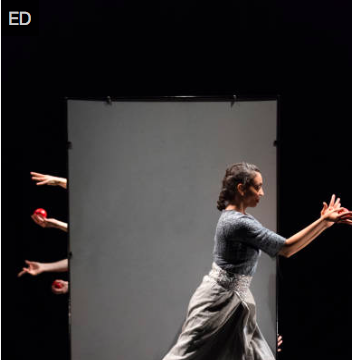Assembly Hall, Edinburgh Festival Fringe; 13th August 2017

Gandini Juggling premiere Sigma at Edinburgh Festival Fringe in one of the Assembly Hall’s smaller spaces, the Rainy Hall. Director Sean Gandini collaborates with Seeta Patel, choreographer and performer of Bharatanatyam, which is an ancient Indian classical dance. The intimate work with four female artists is the eighth show of the company’s current repertoire, which spans both commercial and artistic outlets.
‘Sigma’ is the letter S in the Greek alphabet: in the upper case, meaning to sum up and, in the lower case, expressing variations in value of a set of data. In performance, Sigma adds together the rhythms, gestures and movement of Bharatanatyam dance with the mathematical scores of juggling. The resulting product is a hybrid in form that compliments both juggling and Bharatanatyam techniques by highlighting difference rather than dissolving both styles into one. This work, divided into twelve parts, demonstrates in various ways how the two distinctive styles can be combined, opposed, interlaced or juxtaposed and is, above all, a celebration of form and heritage.

Patel, Indu Panday, Kati Ylä-Hokkala & Kim Huynh are knowing, charming performers who move with delicate dexterity. Two jugglers, Huynh and Ylä-Hokkala, emerge above two screens. Balls and faces rise and set, their lower pathways and launching hands eclipsed. As precise as a surgeon but as a malleable as a jellyfish, Patel moulds her fingers, hands and wrists around undulating currents of air. Near the beginning of the show the gaze is drawn into a central micro-duet between two hands, framed by two screens, and then follows their journey through the length of the performance.

Having carefully established a relationship between viewer and hands, when we next see this tensile clasp applied to a juggling ball it resounds as a satisfying modification. As each stage of the work moves on – highlighted by a regular announcement of the elapsed time – the dynamics, pathways, embodiment of movement, and playful experimentation are increasingly expansive. As the piece climaxes, bodies intertwine creating arcs and curves as arms touch and hands clasp. White balls and sparkling eyes illuminate movement based phrases. In return, dancers mirror, compliment and intercept catches and throws of juggling sections.
Elongated flights of balls carefully mark accents and heavy footwork; spoken counts and spoken cities keep careful time to rhythms and time signatures impossible to fathom. The layering of multiple rhythms – complimenting or at counterpoint between both dancer and juggler and between hand and hand – is my crude attempt at describing the polyrhythmic relationships within this finely tuned masterpiece. Being unable to deconstruct its components mathematically allows the viewer to delight in its visualisation, which is a rich convection current of steady balls, grounded postures and isolated surprises.

A balance between form and personality is carefully struck as each performer introduces themselves and describes where they and their parents are from. Two visibly white and two visibly brown-skinned performers become complex individuals with a variety of places and cultures making up their identities. This subverts expectations and sets a premise for coexistence and transference between the identities and movement vocabularies of each pair. Gandini’s choices cleverly allow for different ways of seeing that reflect the socio-political context of the viewer. As Bharatanatyam gestures are re-contextualised with less emphasis placed on their original meanings, the complexity of the juggling is reconstructed upon the accents and phrases of Bharatanatyam rhythms.
For me, this piece is a celebration of pattern and composition that is so abundant with detail and perfectly constructed that any tiny contextual reference – such as revealing performative methods in counts, titles and times, stating what the piece is and isn’t, or covering and revealing faces with a fabric head piece – elevate in meaning. The content of Sigma will undoubtedly secure its longevity as Brexit unfolds, and its cultural commentary will become even more poignant whilst its visual identity and tempered velocity continue to transfix.
This response was produced as part of the #CircusVoices scheme for developing critical languages around circus arts.





Critical review as poetry even. I loved. Praised be. Landmark litany. Respect. x